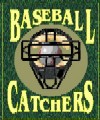 |
|
 |
|
|
| |||
|
STANCE When in the catching stance, you should be in a comfortable crouch, compact and relaxed. Move your entire body to the location of the desired pitch, with your off-hand behind your back. Any time there is a threat of a runner stealing, your right foot should be a little behind the left (left heel to right toes), backside up, and the off-hand should be in a tight fist behind the glove.When receiving the ball, be strong and smooth. Extend your arm and show the umpire the ball. Roll your wrists toward the center of the plate. SETUP Move to the location of the pitch as the pitcher begins his motion and not before. Get your glove up and give the pitcher a target as early as possible. Target the bottom of the zone of a called pitch unless the call is for a high pitch in which case the target will be the top of the zone. SIGNALING When signaling, you need to conceal the signals as you relay them to the pitcher. To do this, your legs should be kept closed, and protect the signs with the glove-hand hanging below the glove side knee. Your signal hand must also be kept in your crotch and not dangling below.Signaling must be clear. Spread your fingers when giving signals. When communicating #2 or #3, use fingers that are separated rather than ones directly next to one another for easier viewing. Also remember there are other ways of signaling. You do not have to use your fingers to relay the signs, a touch system or glove position system works just as well. Always allow the pitcher to give input. FRAMING When framing, you need to extend your arm, go get the ball, and hold the ball for the umpire to see. Roll your wrists toward the plate, but don't pull the ball. Roll and extend in a smooth manner and avoid jerking or snapping the glove. Only frame on strikes and borderline strikes. If the ball is outside the zone, just catch it and throw it back to the pitcher. On low pitches, roll your wrists upwards. It is important to give the umpire a good view. The catcher and the umpire need to work together. BLOCKING When blocking a baseball it is important to get both knees on the ground as quickly as possible. Do not hop up and then hit the ground. Put your glove back against your cup with your fingers down. Do not put your hand on the ground because this will create a ramp for the ball to hit and continue in a forward motion. You want to create a barrier for the ball to bounce off. The shoulders should be kept square to the ball. The eyes are fixed, tracking the ball from where it hit the ground to the point where it hits the catcher on the chest. As soon as you feel the impact of the ball you must pop back up into the catching position and then immediately fetch the ball. Use the scoop method (two hands) to gather in the ball. PLAYS AT HOME When making a tag play at home, your left leg goes on the corner of the plate with the toe
aimed towards third base. You need
to take away the front half of home and give the backside. | |||
| |||
|
FIELDING BUNTS When fielding bunts, you need to always use two hands and scoop the ball. Don't try to pick it up. When the ball is down the first base line or up the middle, circle the ball and overstep it. The ball should be between your legs. Scoop the ball with your body angled towards first base. Next, step back from the baseline and throw the ball to the inside or the outside part of the bag, which ever is communicated.If the ball is down the third base line, you need to come around it with your back towards first base and overstep, to scoop the ball with your body angled toward first base. FIELDING POP-UPS When fielding pop-ups, you need to find the ball and remove your mask, keeping it in hand, and turn back to the infield. Next, get under the ball and throw your mask away. You must call the ball at the point of climax. As the catcher, you need to remember that infielders have priority over the catcher on pop-ups because it is easier for them to catch.HOLDING RUNNERS ON As the catcher, you need to keep runners off balance. You need to be accurate, quick and strong. You need to be able to make snap throws. It is important to make the runners think. To hold runners on, the catcher must always communicate with infielders on pick-offs.BEING A LEADER As the catcher, you are the field general. You must be loud and direct. You always need to know the situation and direct others to act appropriately. You anchor the team from behind the plate. You must be the leader.Catching is by far the most difficult and challenging position to play. Moreover, a catcher must realize that this position requires more than just physical skills. It also requires a catcher, to have 'leadership skills because they are an extension of the coach on the diamond. A wise person once said, "If it were easy everyone would do it." Well catching is certainly not something everyone can do. |
